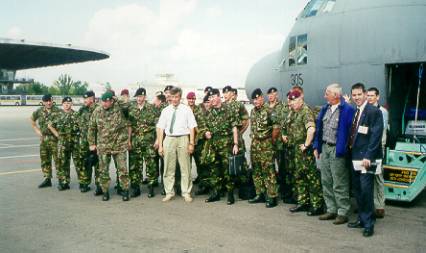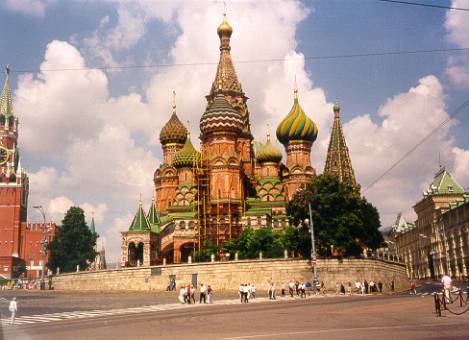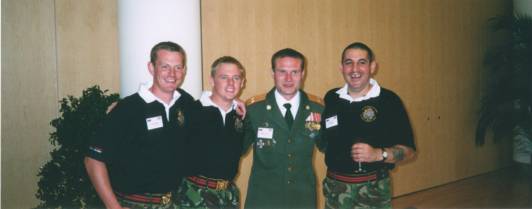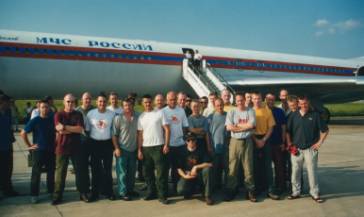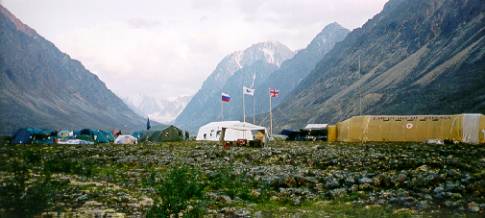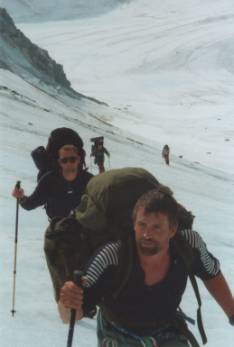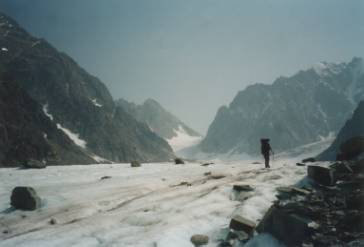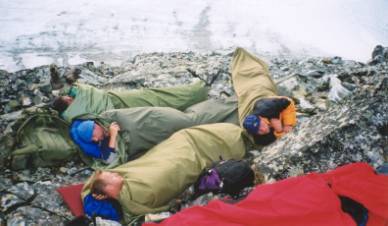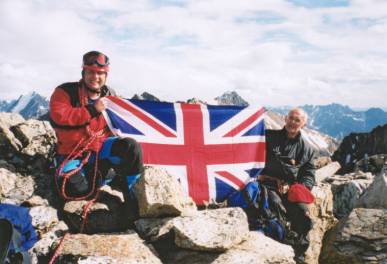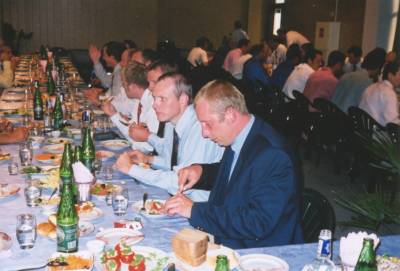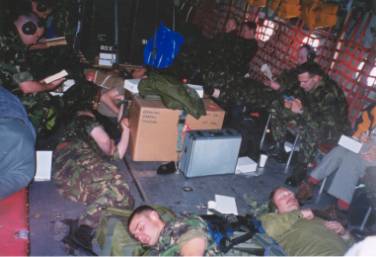|
|
DESTINATIONS: |
 |
Excercise
Siberian Challenge - EXPEDITION
DIARY
14 July. The team moved to RAF Lyneham and boarded a C130 supplied by 2 Gp from RAF High Wycombe at 0800 hours on Saturday morning. The 4 ½ hour flight to Moscow’s main civil airport went without a hitch and we were received by a large reception committee headed by Maj Peter Daniell (the acting MA) and Mr Andrey Legoshin, the Director of the Air Mobile Rescue Service of EMERCOM of Russia. Customs clearance for all personnel was rapid and everyone was soon on a coach to EMERCOM’s HQ at ZHUCORSKY airport some 1 ½ hours to the east. The accommodation provided at the Air Mobile Rescue Service was excellent, with twin rooms and all facilities, even including a Sauna and Satellite television – not exactly what we provided for them in Scotland! At this stage, old friendships from our training in Scotland were renewed and the inevitable reception of vodka and cold beer was provided on the patio. The temperature in Moscow at this stage was a stifling +35C. 15 July. Sunday morning started with a meeting to discuss the Russian customs requirements for the importation of our equipment. Care had been taken not to import sensitive items such as communication equipment, GPS or controlled drugs, however current Russian regulations required a tax to be paid on all goods imported; 40 % on items not being exported again (food and drugs) and 30 % on items temporally imported. Luckily EMERCOM staff were in close contact with the Russian Customs throughout. Problems also occurred with the nomenclature involved in climbing equipment and so explanations were required into the meaning of such items as ‘Dead Men’, ‘friends’ and ‘Balaclavas.’ In
the afternoon a coach was provided by EMERCOM to enable a quick
visit to Red Square and Victory Park.
This enabled British personnel to see two of the key locations
in Moscow, giving them a flavour of the City.
Meanwhile
Maj Tim Smith escorted DRLC around Moscow prior to preparation for
later events at the British Embassy. At 1800 hours a reception was
held in the British Embassy, with all team members wearing Expedition
Rugby shirts and Combat 95, which was to prove very comfortable
in the heat of Moscow. Some
80 guests attended and one felt sympathy for the Russian Military
personnel in full service dress.
At 1815 hours HRH the Princess Royal arrived to meet all
members of the team, not only in her role as Colonel in Chief but
also as Patron for the Expedition.
One of the special guests was Mr Oleg Garizimov who was one
of the first people to traverse the Cherskiy Range and who the organizers
met in 1998 when initially planning the exercise; he was amazed
to see the result of an evening’s conversation at the Russian Geographical
Society in St Petersburg!
She spoke to all members including one who was so overawed
by the occasion that he managed to spill his drink.
The Expedition’s other Patron, Mr Ian McNaught-Davis, the
President of the International Moutaineering and Climbing Federation
(UIAA) was also present; both patrons were in Moscow to attend the
International Olympic Committee meeting which had just selected
Beijing as the venue for the 2008 Olympics.
On
the return from Moscow, evidence of the work undertaken by the Airmobile
Rescue Service was easily seen, as a victim of a traffic accident
was passed 5 km short of the camp and during the day there had been
a further 9 callouts including 3 drownings, 2 traffic accidents
and 3 deaths by fire. 16
July.
Initially Monday was intended to be the day on which equipment
was to be issued, however, delays at customs resulted in a change
of plan. Letters were
required by EMERCOM authorizing them to represent the British Army
in the discussions for the import of the equipment, as well as providing
authority for the movement of the equipment out of the airport.
Therefore, a training day was held which included medical
training and familiarization with the Motorola VHF radios which
would be used by all teams whilst in the mountains. The Russians
would also be providing remote re-broadcasting stations in the mountains
in order to extend communication ranges.
During the morning DRLC visited the training before departing
to meet Deputy Minister Brasnicov who is responsible for International
Cooperation within EMERCOM. The Minister presented DRLC with a commemorative
knife, celebrating the 10th anniversary of EMERCOM in
1998. Four knives had been made, two of which had previously been
presented; one to Saddam Hussein and one to Colonel Gaddafi ! DRLC
then returned to the UK. During
the evening, personnel were escorted out of camp to sample the local
culture and a pleasant bar was soon found.
The local population was most welcoming and were amazed to
see such a large party of British personnel in an area which had
been closed until only 5 years ago.
At this stage the party was joined by three scientists from
Moscow University under Dr Victor Popovnin, an eminent glaciologist.
These 3 assisted by Dr Steve Gurney from Reading University
were to be part of the British Party and their work was endorsed
by Reading University. 17
July.
Tuesday was also spent waiting for the equipment, with it
being finally released late in the evening.
The hard work undertaken by the EMERCOM staff cannot be underestimated,
ensuring a minimum importation tax of US$6,500.
The equipment was then issued during the night and by Wednesday
morning all bulk equipment was loaded, awaiting dispatch to Zhucorsky
Airport. The loading
of the aircraft was undertaken by the Russian Team members due to
restrictions which did not allow our personnel into the airfield.
Initially a large IL-76 was to be used, however, following
an accident involving an IL-76 at Moscow the previous Friday, all
other IL-76’s had been grounded. 18
July.
All 77 personnel and equipment (17 tons) were therefore loaded
onto an IL-62 passenger aircraft which departed on the evening of
Wednesday 18 July. Numerous aircraft were visible including the
TU-144, the Russian version of Concorde.
Minister Vorobiev (First Deputy Minister of EMERCOM) arrived
and speeches were made by the Minister, Andrey Legoshin (Director
of the Air Mobile Rescue Service) and Major Tim Smith, the Expedition
Leader. This was followed by a toast (in Vodka) and some food prior
to boarding the aircraft.
The
flight took 6 hours and crossed 6 time zones. The IL-62 is one of
the more comfortable and quickest of Russian aircraft. Russian loading
and safety procedures are less rigid than European standards and
so there were a few sweating brows during take-off.
The flight arrived in Yakutsk, the capital of Yakutia (Sakhha
Republic) at midday. The idea was then to transfer personnel and
equipment to an MI-8 (HIP) and MI-26 (HALO) helicopter.
Even though the MI-26 can carry some 70 combat troops, the
volume of equipment resulted in the requirement for a double lift.
Difficulties also occurred with the pre-positioning of fuel
for the 900 km flight. The recent floods in Yakutia, which were reported in the international
press, had resulted in the consumption of significant government
stocks and some airheads were now completely depleted.
There was also a requirement for the pre-positioning of a
further 35 tonnes of fuel near the Expedition area.
Other problems were encountered with the possible satellite
footprint affecting the location of base camp and the possibility
of having to pay a ‘tourist’ tax for all personnel, including extra
taxes for photography, berry picking and fishing. These difficulties resulted in the helicopter being delayed
for approximately 10 hours.
The initial lift was to include 10 experienced recce personnel
(including 4 British) in the MI-8 in order to locate base camp.
This was followed by 40 Russians and 14 tonnes of stores to establish
the base camp. The
second lift was include the remaining Russians and British, and
a further 6 tonnes which would be delivered by the MI-26.
The round trip was expected to take 11 hours and with only
1 crew available, only 1 MI-26 lift would occur daily. 19
July.
On Thursday evening the British party were extracted from
the Airport and taken to the Local EMERCOM offices.
Two hours later a local restaurant in Yakutsk was overrun
by 31 people (including Russian scientists from Moscow University)
which resulted in all food and drink stocks being consumed. 20
July.
Friday morning saw the departure of the 1st lift,
some concern was expressed on board the MI-8 when the passengers
were requested to move to the rear to assist take off.
The MI-26 was not expected to return until late evening and
this provided an opportunity for all personnel to visit the town
and conduct some sightseeing.
The local staff also took the team to another Hotel 40 km
south of Yakutsk and to see the River Lena (the ninth longest in
the world that is 6 km wide at Yakutsk).
Personnel also conducted some shopping but there was a limited
number of items to purchase.
Shops are very unlike shops in the West or Moscow, being
small single item kiosks. On returning to base it was discovered
that although the MI-26 had delivered the personnel and equipment
to Base Camp, adverse weather had resulted in it being grounded
in a small town called Moma which was 700 km away from the destination.
This would delay our departure by a further 24 hrs. 21
July.
Saturday morning arrived with rumour and counter
rumour. Generally it seemed to be agreed that any departure would
occur on Monday as the aircraft was still a 4 – 5 hour flight. An
alternative program was rapidly arranged when we were called forward
to the airport to load the MI-26. We arrived, suitably transported
in a Russian military ‘box-body’, to find that most of the aircraft
was already loaded. By 5 pm everything was on board including 6
½ tones of equipment, extra fuel tanks, personal equipment and 23
British and 13 Russian personnel. This required everybody to sit
on top of the equipment. The first leg took 2 hours as the aircraft
flew to Khadiga located at the foothills of Cherskiy. We stopped
for about 1 hour to refuel and then flew for a further 3 hours into
the mountains arriving at 0200 Sunday morning local (Magadan) time
which was a further two hours ahead of Yakutsk and 8 hours ahead
of Moscow. We arrived in twilight as there is no darkness at this
time of the year in Sub-Arctic Siberia. 22 July. On arrival it was
discovered that the Russian main body had established Base Camp
and essential communications. A large accommodation tent had been
allocated to the British, therefore reducing the need to use our
own mountaineering tentage at Basecamp. A number of 4 man tents
were erected in the Base for stores and equipment. The Recce party
had already deployed in order to assess climbing routes and to recce
a location for an Advanced Base Camp. They confirmed during their
regular radio checks that conditions in the valley were severly
hampered by mosquitoes and that movement over ground to Advanced
Base Camp was limited to 2kms per hour.
The weather was a huge surprise to most people, with daily temperatures being in the region of 30-35C with night time temperatures only lowering to between 10-15C. Everyone including the Russians had arrived with extra cold weather equipment, snow goggles and waterproofs only to find that the main clothing required when not climbing was shorts and T-shirts. Following rest, personnel were briefed on Base Camp routine and the general plan for mountaineering and science. The camp was to provide support for 47 Russians and 30 British (including the science party) for 3 weeks and so strict discipline was to be maintained, particularly with regard to personal hygiene. Russian mountaineering regulations were also to be obeyed including the requirement for full written route plans and frequent radio checks. The Russians continued to arrange the Base Camp to include a medical tent with the facility to resuscitate a patient for up to 3 days, an operations tent, shower, sauna, cookhouse and various flagpoles. One Russian party went bear hunting armed with a variety of automatic weapons and shotguns, however the nearest tracks were 1 km down the valley. Partial success was claimed as the hunting team managed to shoot a ‘fish,’ but only after using 12 rounds ! Meanwhile the British continued to expand an Advanced Base Camp some 10 km South of the Base Camp at the foot of 4 glaciers. The Recce team explored the ‘Heart Shaped’ glacier (subsequently named ‘Heart Glacier’) and even managed to scale one of the lower (2607 m) unclimbed peaks, a major achievement on our first full day in the mountains. By the close of the first day, 13 personnel were in the advanced camp, the science team had pre-positioned some equipment at the base of a glacier 4 km away, and one peak had been scaled. 23
July.
Monday
saw the continued stocking of Advanced Base Camp and the mounting
of a second attempt on peak 2607. Due to the experience of the climbers,
coupled with poor ice conditions and the large amount of surface
water, the attempt was undertaken with care and a forward Camp (Camp
1) was therefore established. The first complete science team deployed
consisting of Dr Gurney (Reading University), 3 scientists from
Moscow University and 2 British escorts. They reached the Saragradski
Glacier (the largest in the area) and undertook measurements on
to lower melt area; the glacier was noted to have retreated considerably
over recent years. In the afternoon the Russians started employing
an Advanced Base Camp for their future attempt on Mount Pobeda (the
highest peak in the Cherskiy Range). The inload was assisted greatly
by the use of the MI-8. Following a couple of drams of Oban Whisky
the crew agreed to fly some rations and tentage forward for the
British party thus saving some 16 four man patrols undertaking a
16 hour trek.
The officials of the Moma National Park visited during the afternoon. They came to inform us of the fees required for personnel to stay in the National Park (30 roubles per day per man = $625), EMERCOM successfully wavered the proposed charges for helicopters, berry picking, photographs etc, however it was agreed that the Expedition would provide some photographs to assist the National Park Authorities with their tourism efforts. The party included the Director of the National Park, his ‘debt collector’ and a photographer from the Yakutian National Press. This meeting included the inevitable toasts to each other’s efforts. 24/25 July. News came from Advanced Base Camp that 2 teams including 4 novice climbers had scaled two peaks (2607m & 2595m), a major achievement considering that they were climbing on what was unprotected Scottish Grade 2 conditions. The decision was then taken at Basecamp that there would be considerable potential from Advanced Basecamp to conduct further climbing for at least the next 10 days. It was therefore required to move some stores from Basecamp to Advanced Basecamp, a journey of 7 hours over very difficult glacial moraine and river crossings. Meanwhile, most of the Russian climbers had deployed from Basecamp to the glacier just south of our Advanced Basecamp with the intention of scaling the range’s highest peak, Pobeda. Pobeda is certainly an intention for our team but would likely require a small team of our best climbers. The MI-8 which was based at Moma (also known as Hannu), some 200 km or 1 hour from Basecamp, was now to be based full time at the Basecamp. It was therefore decided to use the MI-8 to move some science equipment as well as rations, tents and fuel up to Advanced Basecamp, thus preventing the enormous logistic exercise, estimated as requiring some 50 portage journeys (or 150 man days in the extreme conditions of the valley) ferrying everything by foot. It was also decided to base our Doctor (Sam Pambakian) at Advanced Basecamp as all climbing activity was now being conducted from there. This left just a small support crew in Basecamp to maintain communications. Meanwhile, the Expedition Leader was in contact with the British Embassy in Moscow trying to arrange a visit of the BBC to the Expedition. An e-mail link to the UK had also been established and messages were now starting to arrive with the obvious benefit to morale. 26 July. By Thursday all our climbers and scientists were operating from the Advanced Basecamp. Two parties under the instructors from the Glencoe Mountain Rescue Team were bivvying at the top of the main glacier prior to an ascent in the early morning, and the science team had taken samples from the main glacier to determine the oxygen levels. Basecamp was essentially there to provide communications, evacuation, essential medical support and resupply. The portable shower is also a very welcome facility. The heat was having significant effects on the glacier and climbing became a case of wading through water on the surface of the ice. The river outside base camp became a torrent, normally it required wading knee deep through icy water but it suddenly became a waist deep obstacle. Two Russian climbers lost their footing and had to be ‘dried’ out following a short swim. 27 July. Friday was the first full day of operation at Advanced Base Camp. One team of climbers undertook an early morning ascent of a 2800 m peak. Most of the other personnel were involved in assisting the two science teams (Moscow and Reading Universities) in recording the glacier and taking samples. 28 July. On Saturday one of the Russian scientists had to return to Base Camp with bad feet. It was noted that the river crossing between the Advanced Base Camp and Base Camp was swollen further and a fixed crossing point was recommended. Upon further investigation this proved impossible as the river changes course each day. As a result a new procedure involving the calling out of the support crew onto the home bank and roping of all personnel crossing was adopted. At midday Tim Smith took advantage of the Russian MI-8 fishing trip and undertook a welfare visit from Base Camp carrying various e-mails received via Moscow and a supply of board games provided by the Doctor to pass the time whilst resting between various expeditions. The evening at Base Camp, although empty due to the Russian fishing trip became lively at the Russians discovered that the addition of ‘Screech’ (powdered lemon or orange drink) supplied in 1 man packs made their ‘home brew’ more palatable. 29
July.
Sunday
saw a quiet day, one party led by Andy Nelson climbed the unmarked
peak that had been previously scaled by a team on Friday, this followed
an overnight bivvy on the top of the glacier. The science team,
working fully together continued to collect samples.
30 July. On Monday the MI-8 helicopter was supposed to return from a Russian hunting party, unfortunately it had ‘broken down’ it is amazing that the Russian Air Force seems to suffer the same mechanical failures when deployed in pleasant areas as the RAF. Meanwhile on the glacier an international ice climbing competition was undertaken, teams were to scale a vertical ice wall, believe it or not the British Team came out winners but mainly due to the team ‘packing’ and the involvement of Andy Nelson (from Glencoe Mountain Rescue). Whilst working on the glacier numerous Russians were observed dressed for glacier work, flip flops and the smallest of underpants. During the evening Tim Smith returned to Base Camp, having taken the opportunity to fly up to the Advanced Camp. On his return he decided the easiest route did not present a sufficient challenge so opted to climb a few extra moraines on the way. A very tired Tim eventually made Base Camp vowing never to climb again. 31 July. Tuesday saw preparations for an assault on Mount Pobeda (Victory) at 3147 m, the highest mountain in the Range. Conditions on the peak are harsh so only 2 personnel were selected for the assault, Andy Nelson and Woody Woodhead moved forward from Advanced Base Camp to establish a camp at the head of the Glacier below Pobeda. Other members of the team prepared to assault adjoining peaks requiring less technical skill. The MI-8 returned from its breakdown during the fishing trip. Carrying a large quantity of fish, one very dead Reindeer, shot with an AK47, and a large quantity of cigarettes and vodka. Sven Northwood watched in amazement as the Russian cook, and ex Col in the Tank Corps, proceeded to produce steaks with the assistance of a felling axe, it is obvious that EEC Health and Safety regulations and rules concerning meat processing have not yet reached Yakutia. 1
August.
Early
Wednesday morning the two climbers set off to conquer the highest
peak. Unfortunately this attempt coincided with a distinct change
in weather. It began to rain with a strong Northerly wind; local
Yakutian experts suggested it was the onset of Autumn. Even though
conditions simulated those of Glencoe the two climbers were forced
back as visibility was reduced to 10 m and the threat of lightening
became apparent. A second team managed to successfully climb Poebeda’s
southern peak at 2885 m before returning to the bivvy.
As conditions deteriorated further it was decided to withdraw from the bivvy at the head of the glacier and concentrate in the Advanced Base Camp. Meanwhile at Base Camp preparations were being made to ‘weather’ the storm, tents were lashed down and the MI-8 secured. The local reporter who had flown in the previous evening prepared herself for an extended stay. The remainder of the day saw all personnel confined to their tents in both the Advanced and Base Camps. Concern was expressed over how long the weather would last and possible extraction problems. 2 August. Thursday saw a complete change – bright sunshine. 2 Aug was the 75th Anniversary of the Russian Airborne Forces and was welcomed by bursts of automatic fire and a number of vodka/hooch toasts were drunk at both Base Camp and on the Glacier. About midday the climbing parties departed for the bivvy camp with the intention of an early assault on Pobeda. Base Camp saw some activity as preparations were made for a fishing trip by MI-8 which was cancelled at the last moment. On the G1 side the improvised Hotmail system was working as far as Base Camp although it was down to Basic Radio Procedure should personnel wish to know the contents of the e-mail. The system has worked for 8,000 miles but the last 8 was back to steam radio. Early Thursday saw another attempt at Mt Pobeda but ended with a total of 7 personnel climbing Mt Soviet Yakutia (2884 m). This was followed by a large change around in personnel at successful climbers left Camp 1 at the head of the glacier and descended to Advanced Base Camp only to be replaced by a new team of climbers. Meanwhile at Base Camp, 3 of the support party departed on a hunting trip armed with a variety of weapons ranging from AK47s and an SKS to fishing rods. At the same time final details were being made concerning the extraction from Cherskiy; over the past couple of days changes in the weather were becoming apparent with colder mornings and stronger winds and experienced local knowledge suggested that the original extraction date of 14 August may be too late as the weather is expected to close in and a new date of 9 – 10 August was set. It is a peculiarity of the region that the change of seasons may be determined with such accuracy. 3 August. Friday saw a change round of parties and those who had successfully climbed Mt Soviet Yakutia returned to Advanced Base Camp whilst new teams set forth for the Camp at the head of the Glacier for a further attempt at the peaks. Meanwhile the Science party (with supporting military) visited a couple of glaciers and took samples. 4/5
August.
Saturday
saw two teams climbing separate peaks. Tim Mayers and a party of
4 climbed Mt Soviet Yakutia whilst Andy Nelson, Sgt Phil Kirby and
Ned Rimmer (Wild Russia) attempted Mt Pobeda. Both parties set off
at 0030 and whilst Soviet Yakutia was climbed by 0350 it was not
until 0655 that Pobeda was conquered. The two parties then returned
to the Camp at the head of the glacier but Andy’s party did not
get down until 1630 making a further return to Advanced Base Camp
unlikely.
A distinct worsening of the weather occurred in the early hours of Sunday (5 Aug) morning. A planned move by personnel from Base Camp forward to assist in the packing of Advanced Base Camp was delayed as a result of poor visibility and rain making the already treacherous route even worse. Base camp started moving some of the scientific samples (125 kg) up onto the Russian Camp on the glacier in order to prepare for the helicopter lift out. Otherwise everyone stayed in their tents to see out to storm. 6 August. Monday saw no change in the weather. Personnel at Advanced Base Camp moved their heavy equipment (scientific samples and tents) to the HLS on the Glacier in preparation for collection by the MI-8. They then started the treacherous route down to Base Camp, the journey being made harder by the slippery conditions. 7 August. By Tuesday morning most personnel were on the move to Base Camp. The scientific team were to remain on the Glacier for a further day. The journey to Base Camp was hindered by the weather conditions which were slippery underfoot. On arrival at Base Camp the Russian parties started to return making a large party in location. The Russians then organized a ‘Banya’ (Sauna) using a tent! It took over 6 hours to prepare and consisted of a pile of stones that were heated by a wooden fire. Following some 5 hours of heating it was then covered by a dampened tent. Then on entering the hot coals were dowsed with cold water producing the required steam for the sauna. Following your 10 minutes of ‘cooking’ you were then given the option of a shower (ice river water) or dipping in the glacial water. It was generally agreed, by those who partook, that the Banya was probably the best item of the expedition. 8 August. Wednesday was initially planned to be the date of departure from the mountains. The MI-8 returned to Base Camp from Moma, containing three ‘hunters’ who had been sent on a 2 day hunt some 5 days earlier with 2 days of rations but had been grounded by the weather. The science team left the glacier and made their way on foot to Base Camp leaving their 200 kg of samples to be moved off the glacier by helicopter. It ended up as a day of failed expectations as the heavy lift helicopter suffered various setbacks due to the cold weather front approaching from the North. There was a coordination problem between the various air traffic regions resulting in it eventually being allowed to fly at 1800 hours only to turn back to Moma because of poor visibility at the entrance to the valley. At this stage all personnel, who had packed all tents and equipment some 12 hours previously, erected some ad-hoc tents in the rain and retired for the night. 9 August. Early Thursday we were informed that the aircraft was on the way, and expectations raised again. This time the MI-26 reached the valley before turning round. Each 200 km trip was using 3 tonnes of fuel and by now over 12 tonnes had been consumed to no avail. Concern was being expressed not just over the cost but the fact there were only limited supplies in Moma. It was also worrying that the weather had defiantly changed ; snow was approaching from the North, winter was arriving and nobody was keen on remaining in the valley. Suddenly on Thursday night we were warned off for the flight. There was to be a 3 hour weather window before the high pressure and snow arrived in the region. It was a case of loading the MI-26 as fast as possible. Some of the Russian party were distinctly ‘under the weather’ not expecting to fly out they had indulged in fuel. The loading frenzy was an experience to our air movements staff as everything was piled onto the MI-26 including extra fuel, rations and some 70 personnel. The aircraft took off with over 21 tonnes on board but did not seem to be overloaded. After an hours flight the aircraft (proceeded by the MI-8) landed at Moma (population 300) the regions capital. A welcome party of the local mayor welcomed us in the usual way with vodka and salad. So good was the welcome that one of the Russians nearly missed the flight out. The MI-8 was unloaded and a secondary run was made for the local population. It was then repacked to the ‘gunnels’ and an extra 5 passengers climbed on board including the local teacher who was taking 2 children to Yakusk hospital (800 km away). 10 August. After refueling a second time in Khadager the aircraft arrived in Yakusk in the early morning of Friday. The connecting IL-62 flew in from Moscow some 4 hours later but ‘surprise surprise’ the airport suddenly closed at midday without warning. The tired passengers made their way to the VIP lounge for ‘a beer’ and one highlight was when our escorting officer went to buy a round at the airport bar and had to remove spare 9mm rounds from his loose change – amazingly airport security took no notice when he passed through the metal detector with a 9 mm automatic pistol. Some more adventurers soon found a local bar with beer at 1/5 of the airport price and by the time we loaded onto the aircraft at 1900 most personnel wished to sleep apart from a few Russians who had also found the vodka store. The 7 hour flight was uneventful and we arrived at 1900 hours in Moscow (having crossed 7 time zones). A welcome party was already assembled at the airport, a toast drunk and we even had a flypast from the SU-35 (BEARKUTZ) the latest Russian fighter with a reverse delta wing. Following some delay we left the airport for EMERCOM’s HQ where everyone had a welcome shower and change of clothing. Some personnel then ‘painted the town red’ and managed to drink all the beer in the local bar. It being pay day, the Russians joined in with one man drinking 3 liters of Vodka before being carried to his bed. 11 August. Saturday was spent, by the majority, cleaning and repacking equipment in preparation for the customs marathon. Everything had to be packed into the original boxes so that customs could check that items imported were exported again otherwise extra taxes would be incurred. 12
August.
Sunday
was to be the official day of sightseeing. A coach and guide were
arranged by EMERCOM to take us to Victory Park and the Kremlin.
Unfortunately we lost a couple of members who had to continue the
customs preparations. The coach tour was provided by INTORIST and
was generally aimed at a civilian audience. Victory park was of
interest not only because of the high class of dioramas representing
Kursk, Moscow and Berlin but because our host provided an interesting
Soviet perspective on the war including the comment ‘in 1942 only
the Soviet Union was fighting the Germans!’ The Kremlin visit was
enjoyed by all and the host kept the audience spellbound with her
explanations of all the treasures in the Armoury including the famous
Faberge eggs. This was followed by a visit to the tomb of the unknown
soldier and an important visit to the Armadillo Bar (near red Square)
that had been adopted as the unofficial watering hole of the various
recce teams. 13
August.
Monday included a formal photograph from the Ambassador’s
residence with the Kremlin in the background.
The start was delayed because of the delights of the Moscow
traffic. This was followed
by a trip to the Red Army Museum which was discovered to be closed
but following a little persuasion from our hosts we were allowed
to view the hardware in the grounds around the museum.
This was followed by a shopping trip in the Olympic area
in Moscow although the most visited establishment was McDonalds.
We returned to Zhukorsky in the early afternoon in preparation
for the evening function.
The meal was hosted by EMERCOM in response to the cocktail party at the Embassy. Unfortunately all principle ministers were absent on a conference but this did not distract from the evening. Major Peter Daniell represented the Embassy and a formal photograph was taken outside the offices. It was a typical Russian meal with a Vodka toast before dining started. This was responded to be Tim Smith who thanked EMERCOM for their assistance, without whom the exercise would not have been possible. There then followed a formal toast to ‘Absent Friends’ and the memorial chapel to those employees of EMERCOM who had died in action was visited. The dinner then broke up into numerous small parties toasting whatever came to mind. The Russians provided an excellent band which was on occasions was supported by LCpl Jay Moreman with his mouth organ, and by a number of singers provided by the British party, particularly SSgt Tony Cheney who sang an excellent ‘Hotel California’. As the evening progressed the British party started to send out recce patrols for beer; the local bar was soon emptied following the production of a bucket with instructions to fill it. As patrols spread further afield new areas were discovered including some unintentionally. There seemed to be the obligatory exchange of clothing with many British wearing the Russian Chenyetscha (the blue and white airborne T-shit) and the following day a Russian Crash rescue team deployed to the airshow suitably dressed with British insignia. The evening was a resounding success and a certain WO2, not renowned for his drinking, seemed ‘under the weather’ the following day. 14
August.
1 month to the day since we arrived. The
ambition was to visit a local market in order to purchase our obligatory
souvenirs. All plans in Russia must be flexible as President Putin
was to visit the air show at Zhukorsky airport and every road was
blocked with police placed every 50 m down the main road. A decision
was made to shop locally, and although the choice was limited most
people obtained the required presents and at a far lower price than
the at normal tourist haunts. Our Russian guides provided an excellent
service and were much appreciated by the team. On return to the
Barracks it was discovered that the C130 would be delayed until
late evening. Most people were relieved at the chance for a rest
although visits were made to say goodbye to Olga (officially the
most beautiful woman in the World) in the local hostelry. Departure
was at 1900 hours; we were led direct to the VIP lounge and given
a snack and a drink. A farewell party was assembled including Embassy
staff and personnel from EMERCOM HQ. Eventually the RAF arrived
and bought their tax free ; this was the indication that things
were ready. Farewells were said and we were transported to the C130.
A security briefing was issued, much to the comments of the passengers
who had flown on a larger aircraft (a helicopter) and were used
to waking up on an aircraft without cargo restraints to see Russians
smoking on the fuel tanks and drinking fuel.
|
